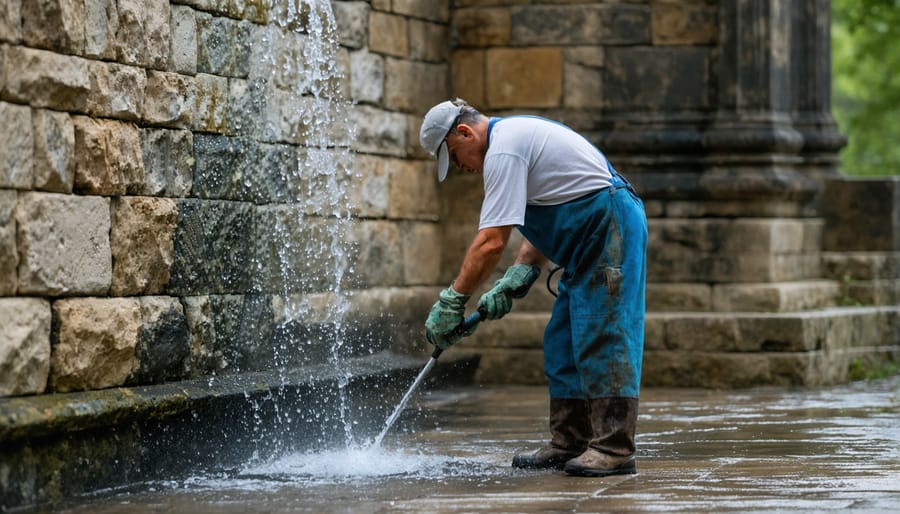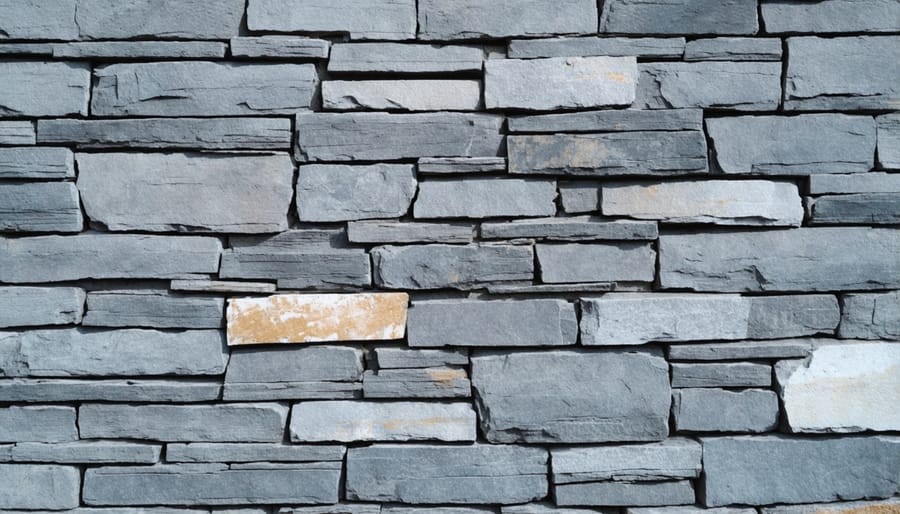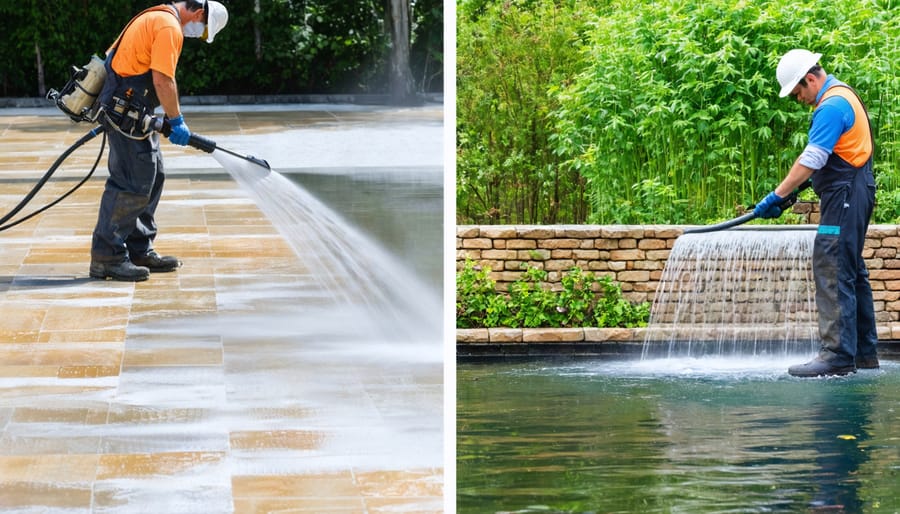At the intersection of environmental stewardship and architectural legacy, historic preservation emerges as a crucial cornerstone of sustainable development. Through modern stone conservation techniques, we’re discovering that the greenest building is often the one already standing. Historic structures embody decades, even centuries, of embodied energy and irreplaceable craftsmanship, while their preservation eliminates the environmental impact of demolition and new construction.
The adaptive reuse of historic buildings reduces landfill waste by up to 80% compared to new construction, while traditional building materials and methods often demonstrate superior durability and energy efficiency. Historic structures, with their thick masonry walls, natural ventilation systems, and locally-sourced materials, frequently outperform modern buildings in sustainability metrics. Their preservation not only safeguards cultural heritage but also serves as a powerful tool in combating climate change.
Today’s preservation practices integrate cutting-edge sustainable technologies with time-tested building techniques, creating a blueprint for environmental responsibility that honors both past and future. This synthesis of old and new demonstrates how historic preservation isn’t just about protecting the past—it’s about ensuring a sustainable future for generations to come.
The Environmental Impact of Traditional Stone Restoration
Resource Consumption in Traditional Methods
Traditional restoration methods often come with significant environmental costs, primarily through their intensive resource consumption. The water usage in conventional cleaning processes can be substantial, with some projects requiring thousands of gallons for pressure washing and chemical cleaning procedures. These methods not only strain local water resources but can also introduce harmful cleaning agents into watershed systems.
Energy consumption presents another major concern. Power tools, heating equipment, and climate control systems used during restoration work contribute to high electricity usage. The transportation of heavy materials and equipment to restoration sites adds to the carbon footprint through fuel consumption and emissions.
Material waste is particularly problematic in traditional approaches. The common practice of removing and replacing damaged materials, rather than repairing them, leads to unnecessary landfill waste. Additionally, the production of replacement materials, especially cement-based products, generates significant carbon emissions. The manufacturing of new stone elements and mortar materials requires extensive energy input and raw material extraction, further impacting natural resources.
These resource-intensive practices often contradict the inherent sustainability of historic structures, highlighting the need for more environmentally conscious restoration approaches.
Chemical Impact and Environmental Concerns
Historic preservation projects often involve dealing with hazardous materials that were commonly used in older construction methods. Lead-based paint, asbestos, and certain chemical sealants pose significant risks to both human health and the environment. When these materials break down or are improperly removed, they can leach into soil and water systems, affecting local ecosystems and wildlife.
Traditional cleaning methods used in restoration work can also introduce harmful substances into the environment. Harsh chemical cleaners, strippers, and solvents may effectively clean historic materials but can contaminate groundwater and harm plant life. Additionally, some preservation treatments containing volatile organic compounds (VOCs) contribute to air pollution and can persist in the environment for extended periods.
To address these concerns, many preservationists now opt for environmentally friendly alternatives. Bio-based cleaners, non-toxic consolidants, and water-based sealers offer effective solutions while minimizing ecological impact. Regular monitoring of treated areas helps ensure that any chemical treatments used in preservation work don’t create long-term environmental problems. This balanced approach maintains historic integrity while protecting surrounding ecosystems for future generations.

Sustainable Restoration Techniques
Eco-friendly Cleaning Methods
Traditional cleaning methods often rely on harsh chemicals that can damage both historic materials and the environment. Fortunately, modern sustainable approaches offer effective alternatives that protect both our heritage and our planet.
Natural cleaning solutions have proven remarkably effective for stone preservation. A mixture of mild, pH-neutral soap and water serves as an excellent general cleaner for most stone surfaces. White vinegar diluted with water, while effective, should be used cautiously on certain stones due to its acidic nature. Baking soda paste works well for stubborn stains without causing damage to delicate surfaces.
Water conservation plays a crucial role in eco-friendly cleaning. Low-moisture cleaning techniques, such as microfiber mops and cloths, effectively remove dirt while minimizing water usage. Steam cleaning, when appropriate for the material, provides deep cleaning with minimal water consumption and no chemical residue.
For larger restoration projects, consider mechanical cleaning methods like soft brushing or controlled air pressure, which require no chemicals and minimal water. These techniques are particularly valuable for exterior stonework and can significantly reduce environmental impact.
Bio-based cleaners derived from plant materials offer another sustainable option. These products break down naturally, leaving no harmful residues while effectively cleaning historic surfaces. Many are now specifically formulated for use on delicate stone and masonry.
When selecting cleaning methods, always test in an inconspicuous area first and consider the specific needs of your historic material. Document successful cleaning approaches for future reference, as this helps establish sustainable maintenance routines that protect both the historic fabric and the environment.

Sustainable Repair and Conservation
Sustainable repair and conservation of historic structures requires a delicate balance between preserving architectural heritage and minimizing environmental impact. Modern conservation practices increasingly emphasize eco-friendly materials and methods that protect both the structure and the environment.
Traditional lime mortars, for instance, have gained renewed appreciation for their sustainable qualities. These mortars are not only historically accurate but also have a lower carbon footprint compared to modern cement-based alternatives. They allow buildings to “breathe,” reducing moisture-related issues while promoting better indoor air quality.
Natural consolidants and protective treatments derived from plant-based sources are revolutionizing marble protection methods. These bio-based solutions offer effective preservation while eliminating the need for harsh chemicals that can harm the environment.
Water-based cleaning systems have largely replaced solvent-based methods, significantly reducing VOC emissions and water pollution. Techniques like micro-abrasive cleaning and laser cleaning provide precise results without generating hazardous waste or damaging the stone’s patina.
Local material sourcing plays a crucial role in sustainable preservation. Using regionally available stone for repairs reduces transportation emissions and supports local economies. Additionally, implementing maintenance plans that emphasize preventive care rather than reactive repairs helps extend the life of historic materials, reducing the need for replacement and conserving resources.
Energy-efficient restoration techniques, such as thermal imaging for damage assessment and targeted repairs, minimize unnecessary intervention while maximizing preservation effectiveness. These approaches help maintain the structure’s historic integrity while reducing the project’s overall environmental footprint.
Balancing Preservation with Sustainability
Material Selection and Sourcing
When selecting materials for historic preservation projects, sustainability should be a primary consideration alongside historical accuracy. Prioritize locally sourced materials to reduce transportation emissions and support regional economies. Look for suppliers who practice responsible extraction methods and offer reclaimed or salvaged materials when possible.
For stone replacement, consider materials with similar physical properties to the original, including porosity, hardness, and thermal expansion characteristics. This ensures long-term compatibility and reduces the need for frequent replacements. Natural stone remains an excellent choice due to its durability and low environmental impact when properly sourced.
Traditional mortars made with lime rather than Portland cement often provide better compatibility with historic masonry while having a lower carbon footprint. These materials allow buildings to “breathe” naturally and can be maintained more sustainably over time.
When selecting wood materials, opt for certified sustainable timber or salvaged wood from demolished structures. For metal elements, consider recycled content and the material’s lifecycle impact. Modern composite materials should be evaluated carefully – while some offer excellent durability and reduced maintenance, others may not age gracefully or be easily recyclable.
Document all material choices and their sources for future reference. This practice helps maintain consistency in repairs and supports informed decision-making for future preservation work while establishing a sustainable procurement chain.

Energy-Efficient Restoration Processes
Energy-efficient restoration requires a balanced approach between preserving historical integrity and implementing modern sustainable practices. During restoration projects, teams can significantly reduce energy consumption through careful planning and innovative techniques.
One effective strategy is establishing temporary climate-controlled zones rather than conditioning entire buildings during work. This targeted approach minimizes energy waste while maintaining necessary environmental conditions for sensitive restoration work. Using LED work lights and energy-efficient tools can further reduce electricity consumption by up to 75% compared to traditional equipment.
Material recycling and reuse plays a crucial role in energy conservation. Salvaging original materials not only preserves historical authenticity but also eliminates the energy costs associated with manufacturing and transporting new materials. When replacement materials are necessary, sourcing them locally reduces transportation-related energy consumption.
Modern technology like thermal imaging helps identify heat loss areas without invasive testing, allowing for more precise and efficient interventions. Installing temporary thermal barriers and using natural ventilation when possible can maintain appropriate working conditions while minimizing energy use.
Many restoration projects now incorporate monitoring systems to track energy usage in real-time, enabling teams to identify and address inefficiencies promptly. Combined with proper worker training in energy-conscious practices, these systems help ensure sustainable restoration processes while maintaining the highest standards of preservation work.
Case Studies in Sustainable Stone Restoration
The successful integration of sustainable practices in historic stone restoration can be best understood through examining real-world projects. The restoration of the Philadelphia City Hall serves as a prime example, where conservators employed breakthrough conservation methods to preserve the building’s marble facade while reducing water consumption by 65% compared to traditional cleaning methods.
In Venice, Italy, the Doge’s Palace restoration project showcases how traditional craftsmanship can merge with sustainable practices. Conservators utilized locally sourced replacement stones and developed a closed-loop cleaning system that filtered and reused water, preventing contaminated runoff from entering the city’s canals. The project also incorporated solar-powered scaffolding lights, reducing energy consumption during the restoration process.
The Sydney Opera House’s ongoing stone conservation program demonstrates long-term sustainability in action. The team implemented a monitoring system using non-invasive sensors to detect early signs of deterioration, allowing for targeted interventions rather than wholesale replacement. This predictive maintenance approach has reduced material waste by 40% and extended the lifespan of original sandstone blocks.
In Edinburgh, Scotland, the Historic Environment Scotland organization restored the McEwan Hall using innovative lime-based mortars mixed with natural hydraulic lime, creating a more environmentally friendly alternative to cement-based products. The project also utilized rainwater harvesting systems for cleaning operations and implemented a waste stone recycling program that repurposed 85% of removed material.
The Washington National Cathedral restoration following earthquake damage in 2011 exemplifies sustainable stone repair practices. Conservators used 3D scanning technology to create precise replacement pieces, minimizing waste and ensuring perfect fits. They also established an on-site stone workshop, reducing transportation emissions and supporting local craftspeople.
These cases demonstrate that sustainable stone restoration isn’t just about environmental protection – it’s about creating efficient, cost-effective solutions that preserve our architectural heritage for future generations. Each project showcases how thoughtful planning and innovative techniques can significantly reduce environmental impact while maintaining the highest standards of conservation.
The intersection of sustainability and historic preservation represents a crucial pathway toward a more environmentally conscious future while honoring our architectural heritage. By embracing sustainable restoration practices, we can significantly reduce the carbon footprint of renovation projects while maintaining the authenticity and character of historic structures.
Throughout this exploration, we’ve seen how traditional preservation methods can be enhanced with modern sustainable approaches. From implementing energy-efficient systems to utilizing environmentally friendly cleaning products and restoration materials, there are numerous ways to achieve both preservation goals and environmental responsibility.
Key takeaways include the importance of life-cycle assessment in restoration projects, the value of retaining and repairing original materials whenever possible, and the benefits of incorporating renewable energy solutions without compromising historical integrity. The case studies presented demonstrate that sustainable preservation is not only possible but often more cost-effective in the long term.
Moving forward, industry professionals and property owners are encouraged to:
– Prioritize reversible interventions that don’t permanently alter historic fabric
– Choose local materials and craftspeople to reduce transportation impacts
– Implement energy-efficient solutions that respect original design features
– Document all restoration work for future reference
– Consider the environmental impact of every preservation decision
By following these principles, we can ensure our historic buildings continue to serve as valuable cultural resources while contributing to a more sustainable future.










